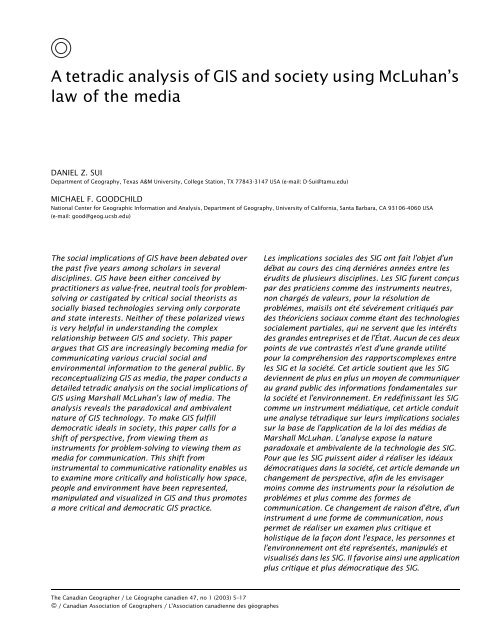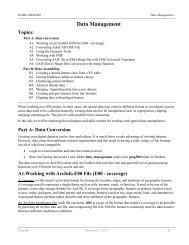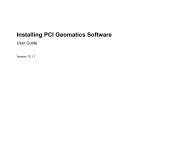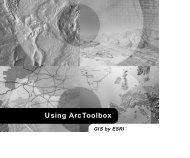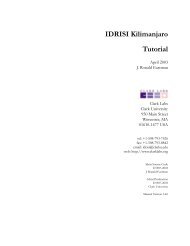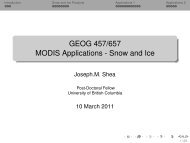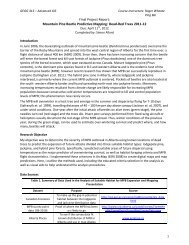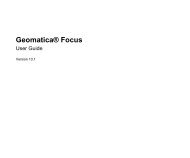Sui, Goodchild - UNBC GIS Lab
Sui, Goodchild - UNBC GIS Lab
Sui, Goodchild - UNBC GIS Lab
You also want an ePaper? Increase the reach of your titles
YUMPU automatically turns print PDFs into web optimized ePapers that Google loves.
A tetradic analysis of <strong>GIS</strong> and society using McLuhan’s<br />
law of the media<br />
DANIEL Z. SUI<br />
Department of Geography, Texas A&M University, College Station, TX 77843-3147 USA (e-mail: D-<strong>Sui</strong>@tamu.edu)<br />
MICHAEL F. GOODCHILD<br />
National Center for Geographic Information and Analysis, Department of Geography, University of California, Santa Barbara, CA 93106-4060 USA<br />
(e-mail: good@geog.ucsb.edu)<br />
The social implications of <strong>GIS</strong> have been debated over<br />
the past five years among scholars in several<br />
disciplines. <strong>GIS</strong> have been either conceived by<br />
practitioners as value-free, neutral tools for problemsolving<br />
or castigated by critical social theorists as<br />
socially biased technologies serving only corporate<br />
and state interests. Neither of these polarized views<br />
is very helpful in understanding the complex<br />
relationship between <strong>GIS</strong> and society. This paper<br />
argues that <strong>GIS</strong> are increasingly becoming media for<br />
communicating various crucial social and<br />
environmental information to the general public. By<br />
reconceptualizing <strong>GIS</strong> as media, the paper conducts a<br />
detailed tetradic analysis on the social implications of<br />
<strong>GIS</strong> using Marshall McLuhan’s law of media. The<br />
analysis reveals the paradoxical and ambivalent<br />
nature of <strong>GIS</strong> technology. To make <strong>GIS</strong> fulfill<br />
democratic ideals in society, this paper calls for a<br />
shift of perspective, from viewing them as<br />
instruments for problem-solving to viewing them as<br />
media for communication. This shift from<br />
instrumental to communicative rationality enables us<br />
to examine more critically and holistically how space,<br />
people and environment have been represented,<br />
manipulated and visualized in <strong>GIS</strong> and thus promotes<br />
a more critical and democratic <strong>GIS</strong> practice.<br />
Les implications sociales des SIG ont fait l’objet d’un<br />
débat au cours des cinq dernières années entre les<br />
érudits de plusieurs disciplines. Les SIG furent conçus<br />
par des praticiens comme des instruments neutres,<br />
non chargés de valeurs, pour la résolution de<br />
problèmes, maisils ont été sévèrement critiqués par<br />
des théoriciens sociaux comme étant des technologies<br />
socialement partiales, qui ne servent que les intérêts<br />
des grandes entreprises et de l’État. Aucun de ces deux<br />
points de vue contrastés n’est d’une grande utilité<br />
pour la compréhension des rapportscomplexes entre<br />
les SIG et la société. Cet article soutient que les SIG<br />
deviennent de plus en plus un moyen de communiquer<br />
au grand public des informations fondamentales sur<br />
la société et l’environnement. En redéfinissant les SIG<br />
comme un instrument médiatique, cet article conduit<br />
une analyse tétradique sur leurs implications sociales<br />
sur la base de l’application de la loi des médias de<br />
Marshall McLuhan. L’analyse expose la nature<br />
paradoxale et ambivalente de la technologie des SIG.<br />
Pour que les SIG puissent aider à réaliser les idéaux<br />
démocratiques dans la société, cet article demande un<br />
changement de perspective, afin de les envisager<br />
moins comme des instruments pour la résolution de<br />
problèmes et plus comme des formes de<br />
communication. Ce changement de raison d’être, d’un<br />
instrument à une forme de communication, nous<br />
permet de réaliser un examen plus critique et<br />
holistique de la façon dont l’espace, les personnes et<br />
l’environnement ont été représentés, manipulés et<br />
visualisés dans les SIG. II favorise ainsi une application<br />
plus critique et plus démocratique des SIG.<br />
The Canadian Geographer / Le Géographe canadien 47, no 1 (2003) 5–17<br />
ß / Canadian Association of Geographers / L’Association canadienne des géographes
6 Daniel Z. <strong>Sui</strong> and Michael F. <strong>Goodchild</strong><br />
Introduction<br />
With the wide-ranging applications of <strong>GIS</strong> 1 that<br />
now exist in various facets of society, especially<br />
their increasing institutionalization in government<br />
agencies at all levels (Masser and Onsrud 1993;<br />
Campbell and Masser 1995; Craglia and Masser<br />
1995; Monmonier 1998), the social implications<br />
of information technology in general and <strong>GIS</strong> technology<br />
in particular have been debated throughout<br />
the 1990s and beyond among scholars in several<br />
disciplines (Chrisman 1987, 1997; Campari and<br />
Frank 1994; Coyne 1995; Sheppard 1995; Pickles<br />
1995, 1997; NCGIA 1996; Harvey 1997; Couclelis<br />
1998; Mugerauer 1998; Yapa 1998; Schuurman<br />
1999, 2000). The traditional conceptualization of<br />
<strong>GIS</strong> as neutral, value-free tools has increasingly<br />
been challenged by critical scholars, yet no consensus<br />
exists on the societal impacts of <strong>GIS</strong> technology.<br />
Although these societal impacts have been<br />
listed as one of the key elements of the National<br />
Science Foundation–sponsored Varenius project<br />
under the banner of ‘geographies of the information<br />
society’ (Sheppard et al. 1999), our current understanding<br />
on this topic remains fragmented, and<br />
there exists no general framework to tie together<br />
all the diverse views. Indeed, as Openshaw<br />
(1996) has so aptly summarized, the discussions<br />
on <strong>GIS</strong> and society have made ‘a lot of fuss about<br />
very little that matters and not enough about that<br />
which does’.<br />
The goal of this paper is to contribute to our<br />
understanding of the relationship between <strong>GIS</strong><br />
and society. By reconceptualizing the role of<br />
<strong>GIS</strong> as media for communicating environmental<br />
and social reality, this paper applies Marshall<br />
McLuhan’s law of media (McLuhan and McLuhan<br />
1988) to conduct a tetradic analysis of the complex<br />
relationship between <strong>GIS</strong> and society and thus<br />
aims to establish a general conceptual framework,<br />
both to examine the social implications of <strong>GIS</strong> technology<br />
and to provide a critical guideline for the<br />
practice of <strong>GIS</strong> in society.<br />
The paper is organized into six sections. After<br />
this brief introduction, a new conceptualization<br />
of <strong>GIS</strong> as media is presented in the second section.<br />
McLuhan’s law of media is introduced in the third<br />
section, and the fourth section uses that law to<br />
conduct a comprehensive analysis of the effects<br />
of <strong>GIS</strong> on society. Further discussions on technological<br />
ambivalence are presented in the fifth section,<br />
followed by concluding remarks in the last<br />
section.<br />
<strong>GIS</strong> as New Media 2<br />
Understanding the relationship between <strong>GIS</strong> and<br />
society is a daunting task, as both terms mean<br />
different things to different people and the relationship<br />
between the two is similarly debatable. A<br />
review of the definitions of <strong>GIS</strong> in the early 1990s<br />
(Maguire 1991) reveals that at least 25 different<br />
definitions were, at that time, widely circulated in<br />
the <strong>GIS</strong> literature. The concept of society is even<br />
more elusive, considering the different theories of<br />
society developed by social scientists and theorists<br />
(Giddens 1984). Although it is beyond the<br />
scope of this paper to resolve the inconsistencies<br />
among these different conceptualizations of <strong>GIS</strong><br />
and of society, it is crucial to re-examine the meaning<br />
of <strong>GIS</strong> in the light of developments that have<br />
occurred in the past five years in order to better<br />
understand its impacts on society.<br />
The dazzling development of <strong>GIS</strong> technology in<br />
recent years has rendered each of the traditional,<br />
mostly instrumental views of <strong>GIS</strong>—as spatial<br />
database, mapping tool and spatial analytical<br />
tool—inadequate to capture the essence of this<br />
technology and its social implications. Each year,<br />
innovative developers offer new software<br />
packages that are easier to use, more powerful<br />
and more easily adopted by users with minimal<br />
training. <strong>GIS</strong> and mapping tools are increasingly<br />
available on the World Wide Web (WWW), and an<br />
increasing number of sites offer advanced <strong>GIS</strong><br />
services, such as route-finding and geocoding.<br />
In-vehicle navigation systems using <strong>GIS</strong> technology<br />
are becoming part of our daily lives (Cowen<br />
1994). In the next two years, cell phones in the US<br />
will be required to be geographically enabled—to<br />
be able to report their current location to an<br />
accuracy of 100 m—in the interests of accurate<br />
response to emergency calls. New imagery with<br />
spatial resolutions as fine as 1 m is becoming<br />
available from commercial sources and is being<br />
distributed through new mechanisms, such as<br />
distributed geolibraries and spatial data clearinghouses<br />
(NRC 1993, 1999). New methods of data<br />
documentation are being used to support widespread<br />
sharing of spatial data via the Internet.<br />
These new trends contrast sharply with the earlier<br />
view, which prevailed into the early 1990s, of <strong>GIS</strong><br />
The Canadian Geographer / Le Géographe canadien 47, no 1 (2003)
Tetradic analysis of <strong>GIS</strong> and society 7<br />
as tools contained within a stand-alone computing<br />
system, serving the needs of their professional<br />
users by performing various forms of analysis too<br />
tedious, time-consuming or expensive to perform<br />
by hand, on data collected and assembled for the<br />
purpose.<br />
Media are generally understood as means of<br />
sending messages or communicating information<br />
to the general public, and mass media are the<br />
instruments by which mass communication takes<br />
place in modern societies. Mass media are also the<br />
most effective means of broadcasting information<br />
to large numbers of people in a short period of<br />
time. In a very general sense, <strong>GIS</strong> can be understood<br />
as a new technological species in an already<br />
crowded media jungle, a species specifically<br />
focused on the communication of geographic<br />
information. The fact that <strong>GIS</strong> communicates geographic<br />
information in digital form merely illustrates<br />
its consistency with contemporary media,<br />
which now make widespread use of digital encoding<br />
at various stages. By reconceptualizing <strong>GIS</strong> as<br />
new media, we can gain fresh insights into the<br />
relationship between <strong>GIS</strong> and society, because the<br />
impacts of media are much better understood<br />
today as a result of years of interdisciplinary<br />
research. In this paper, Marshall McLuhan’s law<br />
of media is invoked to demonstrate how media<br />
theories can shed light on the social implications<br />
of <strong>GIS</strong>.<br />
Before doing so, however, it is appropriate to<br />
take a close look at the meaning of <strong>GIS</strong> as new<br />
media. This thesis can be broadly understood in<br />
at least the following dual senses. First, <strong>GIS</strong><br />
increasingly have become a means to communicate<br />
certain aspects of the real world to the general<br />
public. The Environmental Systems Research Institute<br />
(ESRI, in Redlands, California) advertises its<br />
<strong>GIS</strong> software products as a ‘common language’ for<br />
speaking about and ‘discovering’ the world, while<br />
Intergraph (Huntsville, Alabama) goes so far as to<br />
name its products ‘GeoMedia’. The role of communication<br />
is superseding the three traditional<br />
conceptualizations of <strong>GIS</strong> noted above (as tools<br />
for database management, mapping and spatial<br />
analysis), because the impacts of <strong>GIS</strong> are realized<br />
only when results are presented to people on<br />
screens or on paper. Thus, communication in its<br />
broadest sense must be given the central position<br />
when we discuss relationships between <strong>GIS</strong> and<br />
society. Software vendors may have recognized<br />
this role of <strong>GIS</strong> better than many of their customers<br />
have done. Although data inventory and database<br />
management, automated mapping and spatial<br />
analysis are still predominant tasks of most <strong>GIS</strong><br />
projects, in the end, the goal of all <strong>GIS</strong> operations<br />
is to communicate information to an audience in<br />
society. All <strong>GIS</strong>-related activities serve this final<br />
purpose—to communicate; all other functions,<br />
such as data storage, management analysis and<br />
so on, are intermediate steps serving primarily as<br />
means to communicative ends. For example, analysis<br />
is what the sender uses to expose what the<br />
receiver might not otherwise perceive; database<br />
management makes it easier for the receiver to<br />
understand the content by using standard<br />
structures and metadata.<br />
Second, in the past decade significant changes<br />
have occurred in the part played by digital geographic<br />
information in people’s lives. Sites such<br />
as Mapquest provide millions of users every day<br />
with customized maps of routes and destinations,<br />
and sites such as Terraserver offer digital remotesensing<br />
imagery for sale to the general public. The<br />
Weather Channel and local television stations<br />
present forecasts incorporating geographic information<br />
from satellite images and display maps<br />
of forecasts from advanced computational models<br />
(Monmonier 2000). Airline passengers are presented<br />
with dynamic maps of their flight’s progress.<br />
<strong>GIS</strong> were even featured prominently in the<br />
CBS TV crime-fighting series ‘‘The District’’ (Kaplan<br />
2000). Although humans have always needed to<br />
communicate geographic information in describing<br />
discoveries, giving directions or registering<br />
ownership, recent technological developments<br />
appear to have opened a new range of possibilities<br />
quite different from what we have gotten used to.<br />
Indeed, with the emergence of digital places and<br />
digital individuals (Curry 1998), we are witnessing<br />
not only Toynbee’s (1972) etherialization of history<br />
but also the etherialization of geography.<br />
It should be pointed out that emphasis on the<br />
communication aspect of <strong>GIS</strong> has its parallels in<br />
cartography. Robinson and Petchenik (1975) first<br />
introduced Shannon’s communication theory to<br />
understand the map-making process. Bertin (1978)<br />
further elaborated on linkages between the theory<br />
of communication and the theory of graphics.<br />
Martin (1996) tried to apply the Robinson-Petchenik<br />
communication model of cartography to understanding<br />
<strong>GIS</strong>. By reconceptualizing cartography as<br />
The Canadian Geographer / Le Géographe canadien 47, no 1 (2003)
8 Daniel Z. <strong>Sui</strong> and Michael F. <strong>Goodchild</strong><br />
a language for communication, Tobler (1979)<br />
introduced Chomsky’s (1957) linguistic theory to<br />
develop a ‘transformation theory’ of the cartographic<br />
process. Nyerges (1980) further explored<br />
Chomsky’s ‘deep structure’ versus ‘surface structure’<br />
in both cartographic and <strong>GIS</strong> contexts.<br />
Indeed, the communication paradigm dominated<br />
the cartographic research literature even in the<br />
1970s and the 1980s (MacEachren 1995). The<br />
recent literature on the basic issues of geographic<br />
information science (<strong>GIS</strong>ci) has also invoked<br />
various linguistic metaphors to study geographic<br />
information processing from the perspectives of<br />
communication and linguistics (Frank and Mark<br />
1991; <strong>Goodchild</strong> 2000).<br />
However, the majority of these previous works<br />
is framed by a cognitive approach that focuses on<br />
perception-related issues in map design. The<br />
cognitive approach emphasizes perceptive aspects<br />
of both map-readers and designers at the micro-<br />
(individual) level. In other words, the cognitive<br />
approach has engaged us in discussing technically<br />
oriented syntax issues (rules and grammars<br />
governing the relationships among signifiers);<br />
few authors have touched upon the complex and<br />
problematic semantic issues in geographic information<br />
visualization (the relationship between the<br />
signifier and the signified). Using communication<br />
theorist James Carey’s (1989) words, all these<br />
previous works are dominated by the ‘transmission<br />
view’ of communication at the technical level<br />
(how information is transmitted across space).<br />
What is lacking in the current literature is the<br />
‘ritual view’ of communication at the cultural and<br />
philosophical levels (how information is preserved<br />
in time).<br />
This paper will take up the challenge to examine<br />
cultural and philosophical implications of <strong>GIS</strong> in<br />
society, using McLuhan’s law of media at the<br />
macrolevel. Our current work is conceptually in<br />
line with Harley’s (1989) ground-breaking work in<br />
making the power relationship explicit in the<br />
map-making process, and it resonates with the<br />
recent literature on maps as social constructions<br />
(Crampton 2001). As geographers’ earlier works<br />
have revealed (Burgess and Gold 1985; Zonn<br />
1990; Hay and Israel 2001), media plays an important<br />
role in the public’s perception of many critical<br />
issues in society. How geography is communicated<br />
via the media of <strong>GIS</strong> obviously demands critical<br />
scrutiny.<br />
McLuhan’s Law of Media<br />
Originally trained in literary criticism and medieval<br />
literature, Canadian communication theorist<br />
Marshall McLuhan made his name in the 1960s and<br />
the 1970s with his groundbreaking studies concerning<br />
media’s impacts on individuals and on<br />
society. His studies on media are best represented<br />
by his trilogy: The Mechanical Bride—Folklore<br />
of Industrial Man (1951); The Gutenburg Galaxy—<br />
The Making of Typographic Man (1962); and Understanding<br />
Media—The Extension of Man (1964).<br />
In retrospect, McLuhan was celebrated in the<br />
1960s for the wrong reasons. With the appearance<br />
of CNN, MTV, the Internet, and the World Wide<br />
Web, McLuhan’s writings make much more sense in<br />
1994 than they did in 1964 (Press 1995; Benedetti<br />
and DeHart 1997; Biro 2000; Genosko 2000;<br />
Horrocks 2000). As a controversial figure caught<br />
in a struggle between tradition and modernity, we<br />
believe, McLuhan was deserted by the academy too<br />
early and too soon. It is time to re-evaluate those of<br />
McLuhan’s theories that were hotly contested in<br />
the late 1960s (Stearn 1967; Crosby and Bond<br />
1968; Finkelstein 1968; Rosenthal 1968). As it is<br />
beyond the scope of this paper to present<br />
a comprehensive review of McLuhan’s complex<br />
ideas, readers are referred to Neill (1983), Gordon<br />
(1997) and Grosswiler (1997) for general overviews,<br />
and to Levinson (1999) and Theall (2001)<br />
for McLuhan’s relevance for the new digital age<br />
led by the Internet. What follows is a brief introduction<br />
to McLuhan’s law of media, which will be<br />
used to examine the social implications of <strong>GIS</strong><br />
technology.<br />
Although McLuhan’s followers regard him as a<br />
clairvoyant whose pungent and integrative<br />
insights have functioned as goads to contemporary<br />
thinkers, he was dismissed in the 1970s and<br />
the early 1980s by most social scientists and<br />
literary scholars as a marginal man from a marginal<br />
country who got it all wrong. Just like his<br />
sudden appearance in Woody Allen’s Oscarwinning<br />
movie, Annie Hall, McLuhan was brought<br />
back onto centre stage in media studies in the early<br />
1990s, again hailed by his disciples as a man who<br />
used his probes as drills to pierce the crust of<br />
humankind’s perceptions, constrained and dulled<br />
by the technical environment (Benedetti and<br />
DeHart 1997; Genosko 2000). McLuhan’s obsession<br />
with enlightened insights enabled him to make many<br />
The Canadian Geographer / Le Géographe canadien 47, no 1 (2003)
Tetradic analysis of <strong>GIS</strong> and society 9<br />
hits using his intellectual handgun, the one-sentence<br />
aphorism. Many of McLuhan’s catchy phrases—such<br />
as ‘the global village’, ‘the medium is the message’,<br />
and ‘the TV treats the eye as the ear’—have become<br />
part of the contemporary popular lexicon.<br />
McLuhan and many of his followers believe that<br />
there have been three dominant modes of communication<br />
throughout human history: oral/speech,<br />
writing/printing press, and the electronic medium.<br />
Each dominant medium has produced dramatically<br />
different psychic and physical impacts on individuals<br />
and on society as a whole. McLuhan succinctly<br />
summarized these impacts as the law of media,<br />
presented in the tetradic framework (Figure 1)<br />
in a book coauthored with his son Eric and published<br />
posthumously (McLuhan and McLuhan<br />
1988). McLuhan’s law of media has four major<br />
elements: any innovations in the dominant mode of<br />
communication media will invariably (a) intensify/<br />
enhance certain aspects of human faculties or a<br />
given culture, while at the same time (b) making<br />
certain aspects of human mental abilities or cultural<br />
practices obsolete. Furthermore, all media<br />
innovations also (c) retrieve a phase of certain<br />
human capabilities or cultural practices long ago<br />
pushed aside and (d) undergo a reversal when<br />
extended beyond the limits of their potential. The<br />
four phases of the tetrad manifest, in advance, the<br />
Figure 1<br />
McLuhan’s law of media. SOURCE: Modified after McLuhan and McLuhan<br />
(1988)<br />
cultural impacts of an artefact by showing how<br />
total saturated use would produce a reversal of<br />
original intent.<br />
McLuhan’s law of media interweaves two fundamental<br />
elements key to understanding his tetradic<br />
model: (1) the distinction between visual and<br />
acoustic space and (2) the relationship between<br />
figure and ground as outlined in Gestalt psychology.<br />
According to McLuhan (1964), dichotomous<br />
intellectual discourses are reflections of bifurcated<br />
minds deeply rooted in the visual mode of<br />
thinking—the result of the Gutenberg (printing<br />
press) revolution. McLuhan and Powers (1989)<br />
further argue that the ‘visual space’ mindset leaves<br />
little room for alternatives or for participation<br />
when no provision is made for two entirely different<br />
points of view. The result is usually the exclusion<br />
of alternative perspectives. To fully<br />
comprehend the new reality mediated by the electronic<br />
medium, McLuhan and Powers (1989) call<br />
for a fundamental shift from the values of linear<br />
thinking (visual, proportional space) to those of<br />
the multisensory life (the experience of acoustic<br />
space). Visual thinking places information structurally<br />
and sequentially—having separate centres<br />
with fixed boundaries. Acoustic thinking regards<br />
things as interconnected simultaneously—having<br />
centres everywhere with boundaries nowhere.<br />
Visual thinking is thus centred and bounded.<br />
Acoustic thinking is built on holistic and organic<br />
ontology. Acoustic space has no cardinal centre,<br />
just many centres floating in a cosmic system<br />
that honours only diversity. This shift demands<br />
that we engage in simultaneous understanding<br />
and integral awareness. As one of us has argued<br />
elsewhere (<strong>Sui</strong> 2000), the shift from a predominantly<br />
visual metaphor to an aural one is one of the<br />
major changes in geographical discourses in the<br />
late 20th century. Such a change was made possible<br />
by an array of philosophical, technological,<br />
and social changes in society. At the very fundamental<br />
level, visual and aural thinking entail different<br />
sets of epistemological values, orchestrated<br />
as by the eye versus the ear. We now know that<br />
sound imposes its concreteness on us by immersing<br />
and surrounding us in its field and that sound<br />
tends always to socialize. Voice is inherently relational<br />
and subjective. In contrast, sight entails an<br />
object world fixed in space, giving an illusion of<br />
permanence. Vision is thus inherently detached<br />
and objective.<br />
The Canadian Geographer / Le Géographe canadien 47, no 1 (2003)
10 Daniel Z. <strong>Sui</strong> and Michael F. <strong>Goodchild</strong><br />
Also implicitly woven into McLuhan’s tetrad is<br />
the concept of figure/ground, borrowed from<br />
Gestalt psychology: enhancement and retrieval as<br />
two figures and obsolescence and reversal as two<br />
grounds. Visual thinking usually stresses one figure<br />
or one ground, but rarely both. Acoustic thinking<br />
engages us in double figures and double<br />
grounds and enables us simultaneously to evaluate<br />
the overall effects of an artefact on society.<br />
McLuhan believes that every product of human<br />
effort manifests the same four dimensions. His<br />
tetrad enables us to reposition ourselves into a<br />
holistic perceptive mode—the mode of the dynamically<br />
many-centred—and to move away from the<br />
monolithic linear visual image. Instead of simplistic<br />
utopian and dystopian views, McLuhan’s inclusive<br />
and irreducible four-part law of media<br />
provides a better conceptual framework within<br />
which to understand the relationship between <strong>GIS</strong><br />
and society. As an exploratory probe resting on a<br />
set of questions, instead of a bounded theory, the<br />
tetrad will facilitate our simultaneous understanding<br />
and integral awareness. To confine ourselves<br />
to only one metaphor, as most authors have done<br />
so far, is to engage in synecdoche—to mistake the<br />
part for the whole (<strong>Sui</strong> 1998).<br />
<strong>GIS</strong> and Society: A Tetradic Analysis<br />
If <strong>GIS</strong> are indeed becoming new media for communicating<br />
various forms of social and environmental<br />
information in society (<strong>Goodchild</strong> 2000; <strong>Sui</strong> and<br />
<strong>Goodchild</strong> 2001), it will be interesting to take a<br />
close look at the extent to which McLuhan’s law of<br />
media can be applied to examine the impacts of<br />
<strong>GIS</strong>. Tying the relationship between <strong>GIS</strong> and<br />
society to McLuhan’s law of media, we will conduct<br />
a tetradic analysis by answering the four questions<br />
raised in McLuhan’s framework. In this paper,<br />
society is conceptualized as a collection of complex,<br />
interacting webs of social, economic, political<br />
and cultural relationships among individuals<br />
and institutions.<br />
<strong>GIS</strong> and society I: what do <strong>GIS</strong> enhance?<br />
It is common knowledge, and generally agreed<br />
upon by <strong>GIS</strong> practitioners and critics alike, that<br />
<strong>GIS</strong> have greatly facilitated data inventory and<br />
database management of georeferenced information.<br />
<strong>GIS</strong> also provide users with a variety of<br />
exciting new tools for analyzing and visualizing<br />
geographic information. If we follow McLuhan’s<br />
axiom that all media are extensions of people,<br />
<strong>GIS</strong> have definitely extended human faculties in<br />
several ways. As far as drawing and mapping are<br />
concerned, <strong>GIS</strong> have extended our hands for production<br />
of a variety of virtual and real maps. As<br />
far as fieldwork is concerned, <strong>GIS</strong> have<br />
extended our eyes through increasing integration<br />
with remote sensing and aerial photography. As far<br />
as navigation skills are concerned, <strong>GIS</strong> have<br />
extended the brain’s powers through increased<br />
adoption of car navigation systems and integration<br />
of real-time global positioning systems (GPSs). As<br />
far as human central nervous systems are concerned,<br />
<strong>GIS</strong> have extended our minds and thinking<br />
abilities through integration with artificial intelligence,<br />
expert systems, various kinds of spatial<br />
analysis and modeling and even the incorporation<br />
of emotions into computing processes (Openshaw<br />
and Openshaw 1997; Picard 1997). In many ways,<br />
<strong>GIS</strong> have also enhanced accessibility of geographic<br />
information for a wide range of users throughout<br />
society. Since most <strong>GIS</strong> courses are offered by geography<br />
departments in North America (Morgan 1996),<br />
<strong>GIS</strong> have undoubtedly improved the visibility of<br />
geography both in the academy and in society.<br />
Although numerous organizational issues still<br />
need to be resolved, the rapid diffusion of <strong>GIS</strong> into<br />
various government agencies and corporate settings<br />
not only has greatly enhanced application of<br />
georeferenced information in interesting and exciting<br />
ways, but has also promoted <strong>GIS</strong> as a new science<br />
in and of itself (Wright et al. 1997). From a broader<br />
perspective, <strong>GIS</strong> must be understood as a part of the<br />
information revolution that has transformed our<br />
society from an industrial into a postindustrial one.<br />
During this process, <strong>GIS</strong> certainly have become part<br />
of society’s transition from the mode of production<br />
to the mode of information (Poster 1990).<br />
<strong>GIS</strong> and society II: what do <strong>GIS</strong> make obsolete?<br />
In opposition to predominant techno-utopian<br />
views, McLuhan’s scheme further proposes that<br />
new media and technologies do not simply extend<br />
our various mental and physical faculties. To the<br />
contrary, media also simultaneously make obsolete<br />
(or ‘amputate’) various social practices and<br />
human faculties. By ‘obsolescence’, McLuhan does<br />
not mean the total disappearance or outdating of<br />
certain social practices, but rather that certain<br />
The Canadian Geographer / Le Géographe canadien 47, no 1 (2003)
Tetradic analysis of <strong>GIS</strong> and society 11<br />
media or social practices are no longer dominant.<br />
<strong>GIS</strong> do not simply extend our mapping capabilities<br />
without cost. <strong>GIS</strong> also simultaneously make obsolete<br />
many aspects of traditional cartographic practices,<br />
such as the use of drawing pens. In other<br />
words, <strong>GIS</strong> are killing certain aspects of cartography<br />
as we know it (<strong>Goodchild</strong> 1999). Likewise, for an<br />
increasing number of <strong>GIS</strong> users, the technology has<br />
made obsolete many traditional field techniques<br />
and has even partially eliminated the desire to<br />
collect first-hand data, as so many secondary data<br />
are available in digital format on CD or via the Web.<br />
The reliance on secondary data for research and<br />
social applications has profound legal, ethical and<br />
methodological implications (Sheppard 1993).<br />
During the past decade, we have witnessed more<br />
and more geographic research being conducted in<br />
the office at the computer screen, rather than in<br />
the field. Agencies such as the US Forest Service,<br />
which used to rely heavily on personnel located in<br />
the field, now place more and more emphasis on<br />
digital information management in the office as a<br />
primary agency function. Whether this results in<br />
better forest management is clearly an increasingly<br />
important question. Whether the new development<br />
in field technologies 3 can reverse this<br />
trend remains to be seen.<br />
The impacts of <strong>GIS</strong> on analytical and navigational<br />
skills are even easier to detect. Just as the<br />
use of calculator and cash register has ‘amputated’<br />
mental arithmetic among some users, the increasing<br />
deployment of technologies such as GPS and<br />
wireless computing in the field may be ‘amputating’<br />
or making obsolete valued skills of directionfinding<br />
and navigation. Today, we can easily<br />
generate a digital elevation model (DEM) by simply<br />
pressing a few buttons in ArcView, using either the<br />
inverse distance or Kriging method, but <strong>GIS</strong> users<br />
often express more interest in learning how to<br />
operate a particular software package to produce<br />
impressive output than in understanding how its<br />
algorithms work. One of the consequences of<br />
access to powerful <strong>GIS</strong> tools may be a greater interest<br />
in doing the thing right rather than in doing the<br />
right thing. In McLuhan’s words, the medium is<br />
indeed becoming the message.<br />
<strong>GIS</strong> and society III: what do <strong>GIS</strong> retrieve?<br />
The third element of McLuhan’s framework is that<br />
new media also retrieve certain practices and cultural<br />
elements long regarded as obsolete. One of<br />
the grand themes of his thesis—and perhaps the<br />
most controversial—holds that electronic media<br />
are breaking from the dominant linear thinking<br />
patterns of the printed word, which itself made<br />
obsolete the oral tradition as the dominant mode<br />
of communication in many facets of society. In<br />
sharp contrast to the printing press, which is a<br />
predominately visual medium, electronic media<br />
are aural and tactile, geared toward the ear or<br />
other senses. That is, electronic media are retrieving<br />
many traits of the oral culture—a phenomenon<br />
that Ong (1982) calls the second orality.<br />
In the context of <strong>GIS</strong>, the retrieval aspect has<br />
gone through several stages. The initial success<br />
of <strong>GIS</strong> relied heavily on integration of automated<br />
mapping and database-management systems for<br />
data inventory and database-management purposes.<br />
Deficiencies in analytical capabilities motivated<br />
the <strong>GIS</strong> community to retrieve many of the<br />
techniques developed during the quantitative<br />
revolution, as evidenced by efforts during the late<br />
1980s and early 1990s to link <strong>GIS</strong> with spatial analysis<br />
and modeling tools (<strong>Goodchild</strong> et al. 1992).<br />
These efforts to improve the analytical capabilities<br />
of <strong>GIS</strong> have led to the realization that our current<br />
conceptualizations of space and time in <strong>GIS</strong> are<br />
incomplete (Rundstrom 1991, 1995; Huffman<br />
1996; NCGIA 1996; Pickles 1998; Miller 2000).<br />
Thus, the second major retrieval within <strong>GIS</strong> is the<br />
study and incorporation of naïve geography, as<br />
evidenced by the National Center for Geographic<br />
Information and Analysis (NCGIA) research initiatives<br />
and the Varenius project’s focus on cognitive<br />
models of the geographic world and their potential<br />
role in development of better tools (Egenhofer and<br />
Mark 1995; Mark et al. 1999). The limits of computation<br />
have revealed the vast terrae incognitae that<br />
humanistic geographers have explored using nonscientific<br />
rules (<strong>Sui</strong> 2001). The third major retrieval<br />
effort within <strong>GIS</strong> is the recent endeavour by <strong>GIS</strong><br />
researchers, as well as critical social theorists, to<br />
link <strong>GIS</strong> to various aspects of social theories in<br />
order to guide current practices, as evidenced by<br />
NCGIA’s initiative 19 (I-19) and the emphasis in the<br />
Varenius project on the emerging geography of the<br />
information society. These research efforts<br />
obviously have moved away from the dominance<br />
of mapping (for the eye) to a more multisense/<br />
multimedia mode of representing different voices<br />
and narratives (for the ear). This trajectory of <strong>GIS</strong><br />
The Canadian Geographer / Le Géographe canadien 47, no 1 (2003)
12 Daniel Z. <strong>Sui</strong> and Michael F. <strong>Goodchild</strong><br />
and <strong>GIS</strong>ci development is interpreted as a reflection<br />
of McLuhan’s theme of the retrieval of orality<br />
by electronic media.<br />
Perhaps even more significant is that the retrieval<br />
capabilities of <strong>GIS</strong> remind us of shifting metaphors<br />
in our social discourse—from the visual mode,<br />
dominated by the eye, to the aural mode, dominated<br />
by the ear. What <strong>GIS</strong> have retrieved is<br />
re-emphasis on the role of speech, narrative and<br />
even rhetoric. <strong>GIS</strong> as media do not simply present<br />
beautiful images or maps for people to look at;<br />
behind these pictures is usually a story to be read<br />
or a speech to be heard. Aspects of aurality also<br />
appear, either consciously or unconsciously, in <strong>GIS</strong><br />
design (Gould 1994). In many applications, <strong>GIS</strong><br />
have increasingly become rhetorical devices to<br />
create meaning and discourse (<strong>Sui</strong> 1998). To follow<br />
and understand <strong>GIS</strong> rhetoric, which is similar to<br />
that Smith (1996) demonstrates for geographical<br />
writings in general, we must understand their<br />
tropes and modes and their roles in determining<br />
our conclusions. Instead of regarding <strong>GIS</strong> as ‘a distant<br />
mirror’ faithfully reflecting reality (Pickles<br />
1999), it is perhaps more appropriate to treat <strong>GIS</strong><br />
as ‘a close dialogue’ among different players in<br />
society. By shifting our ocular metaphor to an<br />
aural one, we can be more sensitive to different<br />
voices and, possibly, to silences as well.<br />
At a more anecdotal level, it is perhaps not coincidental<br />
that <strong>GIS</strong> software packages have been<br />
named Idrisi and research projects have been<br />
called the Alexandria Digital Library or the Varenius<br />
project. These names also work to retrieve aspects<br />
of the past and to emphasize connections between<br />
contemporary technology and much older concerns.<br />
<strong>GIS</strong> and society IV: what do <strong>GIS</strong> reverse into?<br />
The last proposition of McLuhan’s law of media is<br />
that when a medium is pushed to its limit, it will be<br />
reversed into the opposite of what it was originally<br />
designed for. In McLuhan’s (1964, 23) words, ‘[W]e<br />
become what we behold; we first make the tools,<br />
then the tools will make us’. Using numerous<br />
examples of human artefacts and technologies,<br />
McLuhan tries to show that in the beginning,<br />
media are extensions of people, but in time people<br />
become extensions of media. When a medium is<br />
pushed to its limit, it becomes the message itself.<br />
Critical scholars of technology give this process a<br />
variety of different names, such as ‘Marx’s alienation’<br />
(Ollman 1977), ‘reversed adoption’ (Veregin<br />
1995), ‘technopoly’ (Postman 1992) and ‘colonization<br />
of lifeworld’ (Habermas 1987). Echoing what<br />
Wittgenstein demonstrated for language, McLuhan<br />
proposes that when a medium is pushed to its<br />
limit, it is no longer just the vehicle, but also the<br />
driver. Indeed, when we surrender our goals and<br />
social practices to the technical requirements of a<br />
machine, the technology itself becomes what Max<br />
Weber called an ‘iron cage’ (Scaff 1989). When this<br />
occurs, the cage locks up our imagination and creativity.<br />
To McLuhan and many of his followers,<br />
media are not simply ‘making-aware’ agents but<br />
also—and perhaps more importantly—‘makinghappen’<br />
agents. Taken in isolation, this reversal<br />
concept may easily be construed as a technologydeterministic<br />
argument. In fact, McLuhan’s law of<br />
media only makes sense when its four elements are<br />
taken into consideration as a whole in his tetradic<br />
framework.<br />
In the context of <strong>GIS</strong>, what worries most social<br />
theorists is that computerization of the natural<br />
and cultural may inevitably lead to the naturalization<br />
and culturalization of the computerized. This<br />
trend, if not deconstructed critically, will have<br />
serious social and philosophical consequences. In<br />
more and more real-world situations, we have witnessed<br />
incidents where organizational mandates<br />
or problems themselves are modified to meet<br />
requirements of <strong>GIS</strong> technology. Data models<br />
force representations on the world by requiring<br />
them to follow certain rules, such as separation of<br />
complex systems into geographical layers or imposition<br />
of crisp, Boolean categories on systems<br />
which are inherently fuzzy. If the only available<br />
means of solving a problem is a <strong>GIS</strong> with no way<br />
of representing uncertainty, it seems much simpler<br />
to ignore uncertainty than to insist on better<br />
tools.<br />
When <strong>GIS</strong> are reversed into their opposites, they<br />
cease to promote democratic practices in society.<br />
Instead, <strong>GIS</strong> developments and applications are<br />
driven by corporate greed or the state’s insatiable<br />
desire to survey and collect intrusive information<br />
from ordinary citizens (Goss 1995). Consequently,<br />
we become slaves of our media, instead of using<br />
media to serve our higher goals and aspirations.<br />
Some critics warn that <strong>GIS</strong>, coupled with other<br />
information technologies, will become a super<br />
Panopticon to monitor and survey, rather than to<br />
The Canadian Geographer / Le Géographe canadien 47, no 1 (2003)
Tetradic analysis of <strong>GIS</strong> and society 13<br />
help, ordinary citizens, especially the truly disadvantaged<br />
(<strong>Sui</strong> 1998).<br />
Perhapsevenmoreproblematicarethephilosophical<br />
consequences that result when <strong>GIS</strong> reverse<br />
into their opposites. Given their increasingly<br />
numerous and versatile visualization capabilities,<br />
<strong>GIS</strong> may give users a false sense of what is real and<br />
thus a very shaky ontology (Gregory 1994; Raper<br />
1997). Even more troubling is that these pictures<br />
make people feel more real—hyperreal, which is, in<br />
fact, unreal. Based upon their studies of the TV<br />
advertising industry, Mitroff and Bennis (1993)<br />
find that deliberate manufacturing of falsehood<br />
and fantasy is not only profitable but has become<br />
part of our culture, as electronic media become the<br />
dominant mode of representation. They further<br />
point out that two kinds of unreality are produced:<br />
(1) artificial reality, in which it is often difficult to<br />
differentiate between actual and virtual worlds,<br />
and (2) pseudoreality, in which attractive presentation<br />
overwhelms the desire to differentiate the<br />
real from the unreal. Turkle (1995, 169) terms the<br />
first form of unreality the ‘Disneyland Effect (the<br />
artificial seems real)’ and the second the ‘Artificial<br />
Crocodile Effect (the fake seems more compelling<br />
than the real)’. These ontological effects have<br />
tended to suppress alternative ways of knowing,<br />
suggesting that <strong>GIS</strong> may become a prison which<br />
traps us into particular modes of knowing and separates<br />
us from the real world and its problems (Curry<br />
1998). To Heidegger (1977), the real danger of the<br />
inherent enframing nature of technology comes not<br />
from potentially lethal machines or the apparatus<br />
of technology itself. Rather, the danger lies in our<br />
becoming increasingly blind to alternative ways of<br />
looking at things as we turn to technology for solutions<br />
to social problems. In this sense, <strong>GIS</strong> as media<br />
represent more than mere exterior aids; they represent<br />
interior transformations of consciousness as<br />
well. When and if this indeed happens, it would be<br />
more apt to say that <strong>GIS</strong> stands for geographic illusion<br />
systems (Couclelis 1996). Indeed, when<br />
pushed to their limits, <strong>GIS</strong> are just the electronic<br />
version of Plato’s cave: what we see on the screen<br />
are only illusions of reality.<br />
Dealing with Technological<br />
Ambivalence<br />
The central theme of McLuhan’s law of media<br />
states that the effects of media (or technologies<br />
in general) on society are inherently paradoxical.<br />
As both Tuan (1989) and Tenner (1996) have elucidated<br />
with fascinating examples, such paradoxical<br />
effects defy simplistic good or bad characterizations<br />
from either technological utopian or dystopian<br />
perspectives. Instead, we must try to grasp<br />
four aspects simultaneously. McLuhan’s implicit<br />
message is that the social impacts of technology<br />
are ambivalent. Excessive use of technologies<br />
always leads to the opposite of what they are<br />
designed for. In the context of <strong>GIS</strong>, it is futile to<br />
debate whether <strong>GIS</strong> are good or bad for society.<br />
The only meaningful question will be: how can we<br />
reveal and deal with the ambivalent nature of <strong>GIS</strong><br />
applications in society?<br />
The reconceptualization of <strong>GIS</strong> as new media<br />
constitutes a fundamental paradigm shift in current<br />
<strong>GIS</strong> practices, from instrumental rationality to<br />
communicative rationality (Habermas 1984, 1987).<br />
It has been argued that most current <strong>GIS</strong> applications<br />
are dominated by instrumental rationality, in<br />
which <strong>GIS</strong> have been treated as a value-free and<br />
neutral tool to generate objective facts. Under<br />
instrumental rationality, the social ends of <strong>GIS</strong><br />
applications are being facilitated, justified and<br />
sometimes even defined by its technical means.<br />
Results of <strong>GIS</strong> applications have been used in practice<br />
to validate action without attending to the<br />
values embedded in the <strong>GIS</strong> media. This paper<br />
argues that such an implicit instrumental conceptualization<br />
of <strong>GIS</strong> in society has unduly restricted<br />
the questions that can be asked and has created a<br />
false sense of objectivity in public discourse.<br />
McLuhan’s work provides us with a powerful<br />
framework to understand the social (sometimes<br />
unintended) consequences of <strong>GIS</strong> applications.<br />
By re-emphasizing the communicative nature of<br />
<strong>GIS</strong> technology, we can better understand the<br />
elusive nature of the <strong>GIS</strong> language. Furthermore,<br />
by appreciating <strong>GIS</strong>’s role as media, we can<br />
better understand how individuals and organizations<br />
systematically manipulate communications<br />
to conceal possible problems and solutions,<br />
manipulate consent and trust and misrepresent<br />
facts and expectations. <strong>GIS</strong> technology, like all<br />
other media and communication tools, can be<br />
abused by individuals and organizations to manipulate<br />
results and to legitimate and impose political,<br />
economic and social agendas. The shift from instrumental<br />
to communicative rationality will enable us<br />
to examine more critically how space, people and<br />
The Canadian Geographer / Le Géographe canadien 47, no 1 (2003)
14 Daniel Z. <strong>Sui</strong> and Michael F. <strong>Goodchild</strong><br />
environment have been represented, manipulated<br />
and visualized in <strong>GIS</strong>, and thus to promote more<br />
democratic <strong>GIS</strong> practice in the social arena.<br />
Although McLuhan successfully identified the<br />
ambivalent nature of technological development,<br />
the solutions he prescribed are controversial.<br />
According to McLuhan, the only way to escape<br />
technological paradoxes is to resolutely oppose<br />
all technological advances (Kroker 1985; Benedetti<br />
and DeHart 1997). This casts McLuhan in the role<br />
of latter-day Luddite and is obviously not a viable<br />
solution. As everything is rapidly becoming computerized<br />
in the emerging information society,<br />
humanity as a whole will run deeper and deeper<br />
into such technological paradoxes. The tools and<br />
technologies we deploy to study society have<br />
increasingly become part of the society we try to<br />
study using those same tools. This technological<br />
self-referentiality, similar in a way to the linguistic<br />
self-referentiality exemplified by Russell’s paradox,<br />
4 will inevitably make it impossible to provide<br />
technical solutions to social problems. To transcend<br />
such a technological paradox, we must<br />
clearly define and continuously redefine our social<br />
goals, not allowing any technologies to dictate<br />
what we do and why we do it. Just as Wittgenstein<br />
(1922) tries so strenuously to prove that we cannot<br />
express everything about language using language<br />
itself, we cannot solve social problems using technologies<br />
such as <strong>GIS</strong> alone. The following statement<br />
from Wittgenstein’s Tractatus Logico-<br />
Philosophicus provides an intriguing perspective<br />
on the theme of this paper:<br />
My propositions are elucidatory in this way: he who<br />
understands me finally recognizes them as senseless,<br />
when he has climbed out through them, on<br />
them, over them. (He must so to speak throw away<br />
the ladder, after he has climbed up on it.)<br />
He must surmount these propositions; then he sees<br />
the world rightly.<br />
Whereof one cannot speak, thereof one must be silent<br />
(Wittgenstein 1922, 148).<br />
Concluding Remarks: The Messages<br />
of <strong>GIS</strong><br />
The meanings of <strong>GIS</strong> have undergone several major<br />
transformations during the past five years. As<br />
Boorstin (1987) pointed out, the supreme law of<br />
the republic of technology is convergence—the<br />
tendency for everything to become everything<br />
else. In the case of <strong>GIS</strong>, they have evolved from<br />
being an arcane tool for mapping and spatial analysis<br />
to becoming an integral part of mass media to<br />
communicate geographic information in society.<br />
Throughout the 1990s, debates about the social<br />
implication of <strong>GIS</strong> technology shifted from simple<br />
attacks on positivism to incorporating more subtle<br />
analyses of the effects of the technology (Schuurman<br />
2000). In this paper, we continue to make an<br />
effort at such analyses. By reconceptualizing <strong>GIS</strong><br />
as media, we aim to develop a more synthetic,<br />
robust framework to better understand the social<br />
implications of <strong>GIS</strong> technology. The tetradic analysis<br />
of <strong>GIS</strong> as media, conducted using McLuhan’s<br />
framework, has revealed some interesting hidden<br />
messages of <strong>GIS</strong>, which defy the frequent dichotomous<br />
characterization of <strong>GIS</strong> as either good or bad.<br />
Instead, <strong>GIS</strong> transmit a complex set of messages of<br />
simultaneous enhancement, obsolescence, retrieval<br />
and reversal in society. By reconceiving <strong>GIS</strong> as<br />
media, we can transcend the instrumental<br />
rationality currently rampant among both <strong>GIS</strong><br />
developers and <strong>GIS</strong> practitioners and cultivate a<br />
more holistic approach to nonlinear relationships<br />
between <strong>GIS</strong> and society. The clear and<br />
present danger is not <strong>GIS</strong> or information<br />
technologies, but our blissful ignorance of the<br />
implications of what they are going to do to<br />
us, because we have concentrated too much on<br />
what <strong>GIS</strong> can do for us. The only sensible way of<br />
dealing with this inherent technological ambivalence<br />
is to always treat <strong>GIS</strong> media as means to<br />
higher social ends.<br />
It is generally accepted as a truism among<br />
students of technological impacts on society that<br />
all technologies are, in a philosophical sense,<br />
Faustian bargains and that we love technology<br />
because our psyches are so narcissistic. Current<br />
applications of <strong>GIS</strong> in society are dominated by<br />
the Narcissus myth—we are obsessed by the pretty<br />
pictures on the screen—and many <strong>GIS</strong> Fausts have<br />
inadvertently sold their souls to the technologies.<br />
Awakening from the Narcissus myth demands<br />
nothing short of a phoenix transformation of our<br />
consciousness (Buttimer 1993). The reconceptualization<br />
of <strong>GIS</strong> as media reveals the Faustian nature<br />
of <strong>GIS</strong> technology and shows us how we can escape<br />
from the Narcissus myth using McLuhan’s law of<br />
The Canadian Geographer / Le Géographe canadien 47, no 1 (2003)
Tetradic analysis of <strong>GIS</strong> and society 15<br />
media. Such an intellectual exercise is aimed at<br />
making <strong>GIS</strong> a real phoenix, rising out of the deconstructive<br />
ashes to new heights. Only by such a<br />
transformation in our consciousness can we make<br />
<strong>GIS</strong> into a Noah’s Ark with which to survive the<br />
current information flood.<br />
Acknowledgements<br />
We thank Helen Couclelis, Jonathan Phillips, Paul Adams,<br />
Rush Cohen, Judith White and Daniel Overton for providing critical<br />
comments on an earlier version of this paper, and Bing Lu for<br />
research assistance. Constructive comments from two anonymous<br />
reviewers are also gratefully acknowledged. The Varenius project<br />
and the Alexandria Digital Library are supported through cooperative<br />
agreements between the University of California, Santa<br />
Barbara, and the US National Science Foundation.<br />
Notes<br />
1 ‘<strong>GIS</strong>’ are used as a plural in this paper.<br />
2 This section draws on our recent editorial in the International<br />
Journal of Geographical Information Science; see <strong>Sui</strong> and<br />
<strong>Goodchild</strong> (2001) for details.<br />
3 Visit the NCGIA’s Web site for the details of Project Battuta.<br />
4 Russell’s paradox is based on examples like this: Consider a<br />
group of barbers who shave only those men who do not shave<br />
themselves. Suppose there is a barber in this collection who<br />
does not shave himself; then, by the definition of the collection,<br />
he must shave himself. But no barber in the collection can shave<br />
himself. (If so, he would be a man who does shave men who<br />
shave themselves.)<br />
References<br />
BENEDETTI, P. and DEHART, N. 1997 Forward through the Rearview<br />
Mirror: Reflections on and by Marshall McLuhan (Cambridge,<br />
MA: MIT Press)<br />
BERTIN, J. 1978 ‘Theory of communication and theory of the graphic’<br />
International Yearbook of Cartography 28, 118–126<br />
BIRO, G.M. 2000 Marshall McLuhan Meets the Millennium Bug (New<br />
York: Uplevel Publishing)<br />
BOORSTIN, D.J. 1987 Hidden History (New York: Harper and Row)<br />
BURGESS, J. and GOLD, J.R. 1985 Geography, the Media, and Popular<br />
Culture (New York: St. Martin’s Press)<br />
BUTTIMER, A. 1993 Geography and the Human Spirit (Baltimore: John<br />
Hopkins University Press)<br />
CAMPARI, I. and FRANK, A.U. 1994 ‘Cultural differences in <strong>GIS</strong>: a basic<br />
approach’ in E<strong>GIS</strong>’94 (Proceedings of European <strong>GIS</strong> Conference),<br />
ed J. Harts, H.F.L. Ottens and H.J. Scholten (Utrecht, the<br />
Netherlands: E<strong>GIS</strong> Foundation) 10–16<br />
CAMPBELL, H. and MASSER, I. 1995 <strong>GIS</strong> and Organizations: How Effective<br />
Are <strong>GIS</strong> in Practice? (London: Taylor and Francis)<br />
CAREY, J.W. 1989 Communication as Culture: Essays on Media and<br />
Society (Boston: Unwin Hyman)<br />
CHOMSKY, N. 1957 Syntactic Structures (The Hague: Mouton)<br />
CHRISMAN, N.R. 1987 ‘Design of geographic information systems based<br />
on social and cultural goals’ Photogrammetric Engineering and<br />
Remote Sensing 53, 1367–1370<br />
—. 1997 Exploring Geographic Information Systems (New York:<br />
John Wiley and Sons)<br />
COUCLELIS, H. 1996 ‘Geographic illusion systems: towards a (very<br />
partial) research agenda for <strong>GIS</strong> in the information age’ in <strong>GIS</strong><br />
and Society: The Social Implications of How People, Space, and<br />
Environment Are Represented in <strong>GIS</strong> ed T. Harris and D. Weiner,<br />
Technical Report 96–7 (Santa Barbara, CA: National Center for<br />
Geographic Information and Analysis) D12–13<br />
—. 1998 ‘Spatial information technologies and societal problems’<br />
in Geographic Information Research: Trans-Atlantic<br />
Perspectives, ed M. Craglia and H. Onsrud (London: Taylor and<br />
Francis) 15–24<br />
COWEN, D.J. 1994 ‘The importance of <strong>GIS</strong> for the average person’<br />
Proceedings of First Federal Geographic Technology Conference,<br />
Washington, DC 7–11<br />
COYNE, R. 1995 Designing Information Technology in the Postmodern<br />
Age: From Method to Metaphor (Cambridge, MA: MIT Press)<br />
CRAGLIA, M. and MASSER, I. 1995 <strong>GIS</strong> Diffusion: The Adoption of Use of<br />
Geographical Information Systems in Local Government in<br />
Europe (London: Taylor and Francis)<br />
CRAMPTON, J.W. 2001 ‘Maps as social constructions: power,<br />
communication, and visualization’ Progress in Human<br />
Geography 25(2), 235–252<br />
CROSBY, H.H. and BOND, G.R. 1968 The McLuhan Explosion: ACasebook<br />
on Marshall McLuhan and Understanding Media (New York:<br />
American Book Co.)<br />
CURRY, M.R. 1998 Digital Places: Living with Geographic Information<br />
Technologies (London: Blackwell)<br />
EGENHOFER, M. and MARK, D.M. 1995 ‘Naive geography’ in Spatial<br />
Information Theory: ATheoretical Basis for <strong>GIS</strong>, ed A.U. Frank<br />
and W. Kuhn, Lecture Notes in Computer Science 988 (Berlin:<br />
Springer-Verlag) 1–15<br />
FINKELSTEIN, S. 1968 Sense and Nonsense of McLuhan (New York:<br />
International Publishers)<br />
FRANK, A.U. and MARK, D.M. 1991 ‘Language issues for <strong>GIS</strong>’ in<br />
Geographical Information Systems: Principles and Applications,<br />
ed D.J. Maguire, M.F. <strong>Goodchild</strong> and D.W. Rhind (Harlow:<br />
Longman Scientific and Technical) 147–163<br />
GENOSKO, G. 2000 McLuhan and Baudrillard: The Masters of Implosion<br />
(New York: Routledge)<br />
GIDDENS, A. 1984 The Constitution of Society (Oxford: Polity Press)<br />
GOODCHILD, M.F. 1999 ‘<strong>GIS</strong> and geography: elements of a debate’<br />
Yearbook of the Association of Pacific Coast Geographers 60,<br />
150–157<br />
—. 2000 ‘Communicating geographic information in a digital age’<br />
in Annals of the Association of American Geographers 90(2),<br />
344–355<br />
GOODCHILD, M.F., HAINING, R. and WISE, S. 1992 ‘Integrating <strong>GIS</strong> and spatial<br />
data: problems and possibilities’ International Journal of<br />
Geographical Information Systems 6, 407–23<br />
GORDON, W.T. 1997 McLuhan for Beginners (Toronto: Writers and<br />
Readers)<br />
GOSS, J. 1995 ‘We know who you are and we know where you live: the<br />
instrumental rationality of geodemographic systems’ Economic<br />
Geography 71, 171–198<br />
GOULD, M.D. 1994 ‘<strong>GIS</strong> design: a hermeneutic view’ Photogrammetric<br />
Engineering and Remote Sensing 60, 1105–1115<br />
GREGORY, D. 1994 Geographical Imaginations (Cambridge, MA: Blackwell)<br />
GROSSWILER, P. 1997 The Method is the Message: Rethinking McLuhan<br />
through Critical Theory (New York: Black Rose Books Ltd.)<br />
HABERMAS, J. 1984 The Theory of Communicative Action Vol. 1<br />
(Boston: Beacon Press)<br />
—. 1987 The Theory of Communicative Action Vol. 2 (Boston:<br />
Beacon Press)<br />
The Canadian Geographer / Le Géographe canadien 47, no 1 (2003)
16 Daniel Z. <strong>Sui</strong> and Michael F. <strong>Goodchild</strong><br />
HARLEY, B. 1989 ‘Deconstructing the map’ Cartographica 26, 1–20<br />
HARVEY, F. 1997 ‘From geographic holism to geographic information<br />
system’ The Professional Geographer 49(1), 77–85<br />
HAY, I. and ISRAEL, M. 2001 ‘‘‘Newsmaking geography’’: Communicating<br />
geography through the media’ Applied Geography 21(2),<br />
107–125<br />
HEIDEGGER, M. 1977 The Question Concerning Technology, and Other<br />
Essays (New York: Garland)<br />
HORROCKS, C. 2000 Marshall McLuhan and Virtuality (New York:<br />
Totem Books)<br />
HUFFMAN, N.H. 1996 ‘You can’t get here from there: reconstructing the<br />
relevancy of design in postmodernism’ in Cartographic Design:<br />
Theoretical and Practical Perspectives, ed C.H. Wood and<br />
C.P. Keller (New York: John Wiley and Sons) 35–53<br />
KAPLAN, K. 2000 ‘Mapping software has role in ‘‘The District’’’ Los<br />
Angeles Times 16 October, D11<br />
KROKER, A. 1985 Technology and the Canadian Mind: Innis/McLuhan/<br />
Grant (New York: St. Martin’s Press)<br />
LEVINSON, P. 1999 Digital McLuhan: AGuide to the Information<br />
Millennium (New York: Routledge)<br />
MACEACHREN, A.M. 1995 How Maps Work: Representation, Visualization,<br />
and Design (New York: Guilford Press)<br />
MAGUIRE, D.J. 1991 ‘An overview and definition of <strong>GIS</strong>’ in Geographical<br />
Information Systems: Principles and Applications, ed D.J. Maguire,<br />
M.F. <strong>Goodchild</strong> and D.W. Rhind (Harlow: Longman Scientific and<br />
Technical) 9–20<br />
MAPQUEST http://www.mapquest.com (last accessed 13 January<br />
2003)<br />
MARK, D.M., FREKSA, C., HIRTLE, S.C., LLOYD, R. and TVERSKY, B. 1999 ‘Cognitive<br />
models of geographic space’ International Journal of Geographical<br />
Information Science 13(8), 747–774<br />
MARTIN, D. 1996 Geographic Information Systems: Socioeconomic<br />
Applications 2nd ed. (London: Routledge)<br />
MASSER, I. and ONSRUD, H.J. 1993 Diffusion and Use for Geographic<br />
Information Technologies (Boston: Kluwer Academic Press)<br />
MCLUHAN, M. 1951 The Mechanical Bride: Folklore of Industrial Man<br />
(New York: Vanguard Press)<br />
—. 1962 The Gutenberg Galaxy: The Making of Typographic Man<br />
(Toronto: University of Toronto Press)<br />
—. 1964 Understanding Media: The Extension of Man (London:<br />
Sphere Books)<br />
MCLUHAN, M. and MCLUHAN, E. 1988 Laws of Media: The New Science<br />
(Toronto: University of Toronto Press)<br />
MCLUHAN, M. and POWERS, B.R. 1989 The Global Village: Transformations<br />
in World Life and Media in the 21st Century (New York: Oxford<br />
University Press)<br />
MILLER, H.J. 2000 ‘Geographic representations in spatial analysis’<br />
Journal of Geographical Systems 2(1), 55–60<br />
MITROFF, I.I. and BENNIS, W. 1993 The Unreality Industry: The Deliberate<br />
Manufacturing of Falsehood and What It Is Doing to Our Lives<br />
(New York: Oxford University Press)<br />
MONMONIER, M. 1998 ‘The three Rs of <strong>GIS</strong>-based site selection:<br />
representation, resistance and ridicule’ in Policy Issues in<br />
Modern Cartography, ed D.R.F. Taylor (London: Pergamon)<br />
164–175<br />
—. 2000 Air Apparent: How Meteorologists Learned to Map, Predict,<br />
and Dramatize Weather (Chicago: University of Chicago Press)<br />
MORGAN, J.M. 1996 Directory of Academic <strong>GIS</strong> Education (Dubuque, IA:<br />
Kendall/Hunt Publishing Co.)<br />
MUGERAUER, R. 1998 ‘Qualitative <strong>GIS</strong>: to mediate, not dominate’ in<br />
Information, Place, and Cyberspace: Issues in Accessibility ed<br />
D.G. Janelle and D.C. Hodge (Berlin: Springer) 317–338<br />
NATIONAL CENTER FOR GEOGRAPHIC INFORMATION AND ANALYSIS (NCGIA) 1996<br />
Advancing Geographic Information Science: A Research Agenda<br />
Santa Barbara, CA: National Center for Geographic Information<br />
and Analysis http://www.ncgia.ucsb.edu/secure/main.html<br />
—. Project Battuta http://dg.statlab.iastate.edu/dg/ (last accessed<br />
13 January 2003)<br />
NATIONAL RESEARCH COUNCIL (NRC) 1993 Toward a Coordinated Spatial<br />
Data Infrastructure for the Nation (Washington, DC: National<br />
Academy Press)<br />
—. 1999 Distributed Geolibraries: Spatial Information Resources<br />
(Washington, DC: National Academy Press)<br />
NEILL, S.D. 1983 Clarifying McLuhan (Westport, CT: Greenwood Press)<br />
NYERGES, T.L. 1980 ‘Modeling the structure of cartographic<br />
information for query processing’ Ph.D. dissertation, Ohio<br />
State University<br />
OLLMAN, B. 1977 Alienation: Marx’s Conception of Man in Capitalist<br />
Society (New York: Cambridge University Press)<br />
ONG, W.J. 1982 Orality and Literacy: The Technologizing of the Word<br />
(New York: Methuen)<br />
OPENSHAW, S. 1996 ‘<strong>GIS</strong> and society: a lot of fuss about very little that<br />
matters and not enough about that which does’ in <strong>GIS</strong> and<br />
Society: The Social Implications of How People, Space, and<br />
Environment Are Represented in <strong>GIS</strong> ed T. Harris and D. Weiner,<br />
Technical Report 96–7 (Santa Barbara, CA: National Center for<br />
Geographic Information and Analysis) D54–58<br />
OPENSHAW, S. and OPENSHAW, C. 1997 Artificial Intelligence in Geography<br />
(New York: John Wiley and Sons)<br />
PICARD, R.W. 1997 Affective Computing (Cambridge, MA: MIT Press)<br />
PICKLES, J. 1995 Ground Truth: The Social Implications of Geographic<br />
Information Systems (New York: Guilford Press)<br />
—. 1997 ‘Tool or science? <strong>GIS</strong>, technoscience, and theoretical turn’<br />
Annals of the Association of American Geographers 87(2),<br />
363–372<br />
—. 1998 ‘Arguments, debates, and dialogues: the <strong>GIS</strong>-social theory<br />
debate and the concern for alternatives’ in Geographical<br />
Information Systems: Principles, Techniques, Management and<br />
Applications ed P.A. Longley, M.F. <strong>Goodchild</strong>, D.J. Maguire and<br />
D.W. Rhind (New York: John Wiley and Sons) 49–60<br />
—. 1999 ‘Cartography, digital transitions, and questions of history’<br />
in Proceedings, International Cartographic Association Assembly,<br />
Ottawa, August (Ottawa: Canadian Institute of Geomatics)<br />
CD-ROM<br />
POSTMAN, N. 1992 Technopoly: The Surrender of Culture to<br />
Technology (New York: Knopf)<br />
POSTER, M. 1990 The Mode of Information: Poststructuralism and<br />
Social Context (Chicago: University of Chicago Press)<br />
PRESS, L. 1995 ‘McLuhan meets the Net’ Communications of the ACM<br />
38(7), 15–20<br />
RAPER, J. 1997 ‘Unresolved problems of spatial representation’ in<br />
Advances in <strong>GIS</strong> Research II ed M.J. Kraak and M. Molenaar<br />
(London: Taylor and Francis) 917–928<br />
ROBINSON, A.H. and PETCHENICK, B.B. 1975 ‘The map as a communication<br />
system’ The Cartographic Journal 12(1), 7–14<br />
ROSENTHAL, R. 1968 McLuhan: Pro and Con (Baltimore: Penguin)<br />
RUNDSTROM, R. 1991 ‘Mapping, postmodernism, indigenous people,<br />
and the changing direction of North American cartography’<br />
Cartographica 28, 1–12<br />
—. 1995 ‘<strong>GIS</strong>, indigenous peoples, and epistemological diversity’<br />
Cartography and Geographic Information Systems 22(1), 45–57<br />
SCAFF, L.A. 1989 Fleeing the Iron Cage: Culture, Politics, and<br />
Modernity in the Thought of Max Weber (Berkeley: University of<br />
California Press)<br />
The Canadian Geographer / Le Géographe canadien 47, no 1 (2003)
Tetradic analysis of <strong>GIS</strong> and society 17<br />
SCHUURMAN, N. 1999 Critical <strong>GIS</strong>: Theorizing an Emerging Science<br />
Cartographica Monograph no. 53 (Toronto: University of<br />
Toronto Press)<br />
—. 2000 ‘Trouble in the heartland: <strong>GIS</strong> and its critics in the 1990s’<br />
Progress in Human Geography 24(4): 569–590<br />
SHEPPARD, E. 1993 ‘Automated geography: what kind of geography for<br />
what kind of society?’ The Professional Geographer 45, 457–460<br />
—. 1995 ‘<strong>GIS</strong> and society: towards a research agenda’ Cartography<br />
and Geographic Information Systems 22, 5–16<br />
SHEPPARD, E., COUCLELIS, H., GRAHAM, S., HARRINGTON, W. and ONSRUD, H. 1999<br />
‘Geographies of the information society’ International Journal of<br />
Geographical Information Science 13(8), 797–824<br />
SMITH, J.M. 1996 ‘Geographic rhetoric: modes and tropes of appeal’<br />
Annals of the Association of American Geographers 86(1), 1–20<br />
STEARN, G. E. 1967 McLuhan: Hot and Cool (New York: Dial Press)<br />
SUI, D.Z. 1998 ‘Deconstructing virtual cities: from unreality to<br />
hyperrealtiy’ Urban Geography 19(7), 657–676<br />
—. 2000 ‘Visuality, aurality, and the shifting metaphors in<br />
geographic thought in the late 20th century’ Annals of the<br />
Association of American Geographers 90(2), 322–343<br />
—. 2001 ‘Terrae incognitae and limits of computation: whither<br />
<strong>GIS</strong>cience?’ Computers, Environment, and Urban Systems 29(5),<br />
529–533<br />
SUI, D.Z. and GOODCHILD, M.F. 2001 ‘Are <strong>GIS</strong> becoming new media?’<br />
International Journal of Geographical Information Science<br />
15(5), 387–390<br />
TENNER, E. 1996 Why Things Bite Back: Technology and the Revenge of<br />
Unintended Consequences (New York: Knopf)<br />
TERRASERVER http://www.terraserver.com<br />
THEALL, D.F. 2001 The Virtual Marshall McLuhan (Montreal: McGill<br />
University Press)<br />
TOBLER, W.R. 1979 ‘A transformational view of cartography’ The<br />
American Cartographer 6(2), 101–106<br />
TOYNBEE, A. 1972 AStudy of History Updated ed. (New York:<br />
Weathervane Books)<br />
TUAN, Y.F. 1989 Morality and Imagination: Paradoxes of Progress<br />
(Madison: The University of Wisconsin Press)<br />
TURKLE, S. 1995 Life on the Screen: Identity in the Age of the Internet<br />
(New York: Simon and Schuster)<br />
VEREGIN, H. 1995 ‘Computer innovation and adoption in geography:<br />
A critique of conventional technological models’ in Ground<br />
Truth: Social Implications of Geographic Information Systems<br />
ed J. Pickles (New York: The Guilford Press) 88–112<br />
WITTGENSTEIN, L. 1922 Tractatus Logico-Philosophicus (London:<br />
Routledge and Kegan Paul Ltd.)<br />
WRIGHT, D.J., GOODCHILD, M.F. and PROCTOR, J.D. 1997 ‘<strong>GIS</strong>: tool or science?’<br />
Annals of the Association of American Geographers 87, 346–362<br />
YAPA, L. 1998 ‘Why <strong>GIS</strong> needs postmodern social theory, and vice<br />
versa’ in Policy Issues in Modern Cartography ed D.R.F. Taylor<br />
(London: Pergamon) 191–201<br />
ZONN, L. 1990 Place Images in Media: Portrayal, Experience, and<br />
Meaning (Savage, MD: Rowman and Littlefield)<br />
The Canadian Geographer / Le Géographe canadien 47, no 1 (2003)


